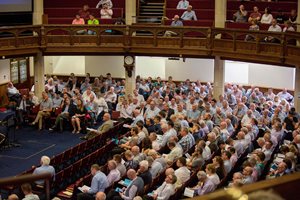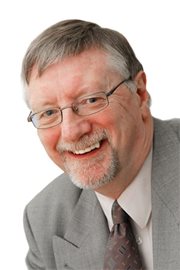The Assembly seeks to be open and transparent and whilst most sessions are open to the public except for the Judicial Commission, we recognise that not every Presbyterian can attend in person due to work and other commitments. With the recent live stream of Assembly business, you don’t have to be sitting in the gallery of the Assembly Hall in Belfast to listen to the debate. From the comfort of your own office or living room, you can tune in to hear what some of the Councils have been up to and what they plan to do in the future.
For some, the formalities may seem a little foreign so here are some explanations to help anyone who will be attending, or listening to, the Assembly for the first time:
- Members of Assembly consist of all ministers in active duty or retired and some elders, ex officio, together with a representative elder from each established congregation plus other elders commissioned by presbyteries to correspond with the number of ministers serving in special appointments. The Assembly quorum is fifty members.

- Members should stand when the Moderator enters or leaves at the beginning or end of proceedings. Members may enter or leave at any time during proceedings, but should do so with as little disturbance as possible. It is a courtesy in so doing to give a slight bow to the Chair.
- Work for which the Assembly is responsible is generally entrusted to various General Assembly Councils and Commissions. These must each present a report to the Assembly. Councils normally have a number of General Assembly committees working under them, along with permanent panels and ad-hoc task groups.
- Reports of Councils: While the Assembly is obliged to ‘receive’ the report of each council, it does not ‘adopt’ or accept responsibility for the contents of any report. Reports are first of all ‘presented’ and the appended resolutions ‘proposed’ en bloc, usually by a council convener. The resolutions are then ‘seconded’ en bloc.
- Questions to Commissions or Councils should only be asked for further information or explanation, whether of something in the report or not in the report but for which the council carries responsibility. Questions should be written out and placed in the box provided as early as possible during the Assembly.
- Resolutions of Councils are then taken in succession, as printed in the General Assembly Reports, and on occasion also in the Supplementary Reports. Resolutions are called by number. Those wishing to speak should at once come forward, or otherwise indicate to the Moderator their desire to speak. It’s helpful if people move to sit on one of the seats reserved on the front row, ready for the Moderator to call them.
- Timings during debate: Speeches presenting and seconding a group of reports and resolutions are limited to seven minutes each. All other speeches must be shorter than four minutes. A flickering light is given one minute before the end, a steady light for 30 seconds and a buzz when the time is up. Before commencing, speakers should announce their name and Congregation (or PW, SPUD etc) and Presbytery.
- In recent years, the Assembly have conducted some business using an alternative format. This year, the Council for Congregational Life and Witness will give their alternative presentation at 7pm on Tuesday 4 June and the Council for Public Affairs will give theirs at 1.45pm on Thursday 6 June.
- Amendments may be moved without prior notice by any member so as to change the terms of a resolution within its general scope but not so as to introduce another subject. Before debate on an amendment commences, the amendment must be given in writing to the Clerk’s desk.
- When a matter is not covered by existing resolutions from a council an additional resolution may be submitted by any member or associate as notice of motion for license.
- Voting will normally be by voice, when the Moderator calls for those in favour to say “Aye” and those against to say “No”. The Moderator may also call for a standing vote, with voting cards displayed, to be counted. A vote by ballot will be held when asked for by not fewer than twenty-five members or at the discretion of the Moderator, by the use of voting tickets, to be counted by tellers.
- Overtures are proposals for a change in the Code, the Church’s Constitution and Government. Changes in rules, of which notice has been given in the printed Reports, may be adopted if approved by a two-thirds majority, or without such notice if approved with no one voting against. If approved by a lesser majority it is ‘placed on the books’, to be decided upon at the following Assembly.
- Memorials: These are petitions to the Assembly, usually from some person or body who is not a member of Assembly, such as a subordinate court of the Church, a Church member or group of members, or persons unconnected with the Church.
We hope by explaining some of these terms, you will be more familiar with the phrases used during #pciga19.
 Very Rev Dr Roy Patton is convener of the Assembly Business Committee. He served as Moderator in 2012-2013. These guidelines are an amended version of the guidance notes outlines in the 2019 Annual Report. You can read the full guide here.
Very Rev Dr Roy Patton is convener of the Assembly Business Committee. He served as Moderator in 2012-2013. These guidelines are an amended version of the guidance notes outlines in the 2019 Annual Report. You can read the full guide here.